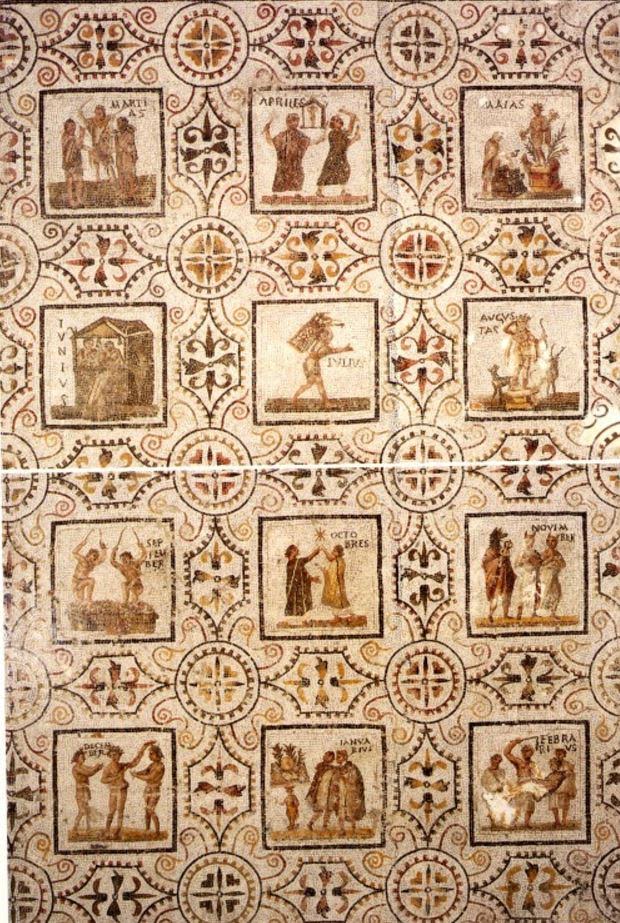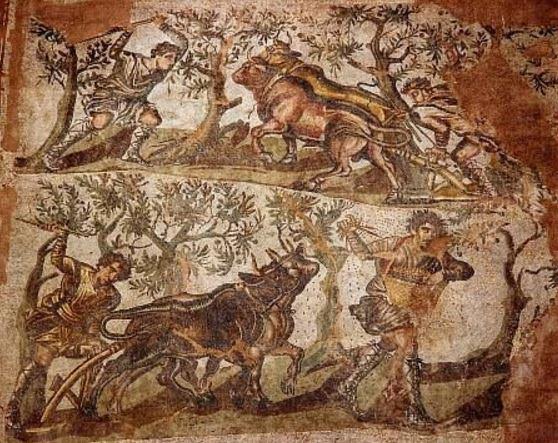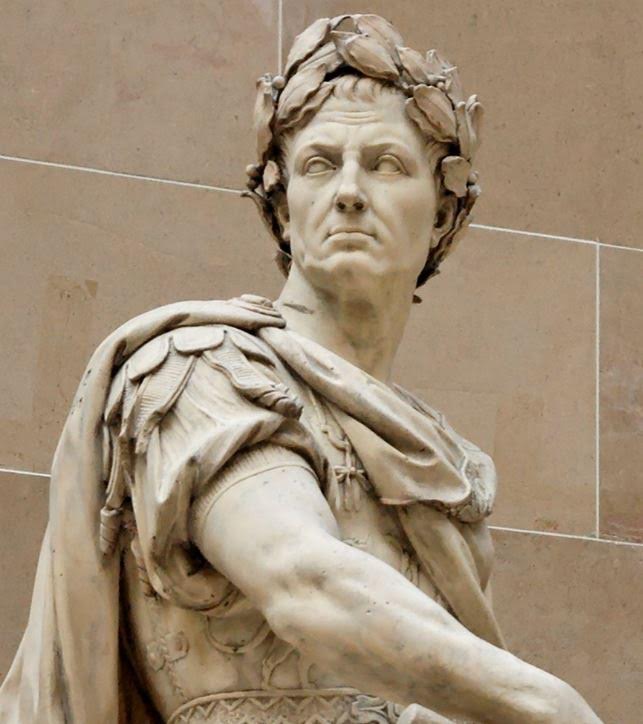
Salve!
Welcome to the second part in this mini, Ancient Everyday blog series about Time in the Roman world.
Last week we took a brief look at how the Romans tracked and organized the years. If you missed it, you can read it by CLICKING HERE.
This week, we’re going to take a look at what is perhaps one of their greatest legacies – the Calendar.
The calendar ranks right up there, and even though we take time for granted, it is actually something that we are constantly aware of. Quite the conundrum, if you ask me!

Roman mosaic representation of the months from North Africa
The word ‘calendar’, as well as the names of the months we still use today are of Roman origin.
However, the calendar went through some reform before it got to the version we are now familiar with.
The original Roman calendar, known as the ‘Calendar of Romulus’, was an agricultural, 10-month year. There were ten irregular months with a total of 304 days from March to December.
The names of these months originated then, and the gap of missing months accounts for the period of time in which no agricultural work was carried out. This was also a lunar cycle, so there was a degree of ‘seasonal drift’ compared to the solar cycle.

Working the fields
It is believed that the change to a 12-month calendar occurred in the sixth century B.C.
In the year 153 B.C., January was made the first month of the year, named after Janus, the god of doorways and new beginnings.
But until Julius Caesar’s calendar reform, the Roman year was 355 days long, divided into 12 months. Four of these had 31 days (March, May, July, and October), seven months had 29 days, and February had 28 days.
Here are the names of the months on the Roman calendar:
Ianuarius (the month of ‘Janus’)
Februarius (the month of ‘Februa’, purgings or purifications)
Martius (the month of ‘Mars’)
Aprilis (uncertain meaning)
Maius (uncertain meaning)
Iunius (the month of ‘Juno’)
Quinctilis (the ‘fifth’ month – renamed ‘Iulius’ in 44 B.C. after Julius Caesar)
Sextilis (the ‘sixth’ month – renamed ‘Augustus’ in 8 B.C. after Emperor Augustus)
September (the ‘seventh’ month)
October (the ‘eighth’ month)
November (the ‘ninth’ month)
December (the ‘tenth’ month)
Notice how some of these names are a legacy of the 10-month agricultural Roman calendar year?

A reproduction of the Fasti Antiates Maiores (c. 60 B.C.) – Wikimedia Commons
There is apparently some evidence for ‘intercalation’, that is, the addition of days to adjust the year. This included the addition of 22-23 days every other year in February.
The act of intercalation was the domain of the pontiffs of Rome, but it was not accurate, and by the time of Julius Caesar, the civic year was about three months ahead of the solar year that was in use.
Caesar extended the year 46 B.C. to 445 days to remove the discrepancy.
So, from January 1st, 45 B.C. he made the year 365 days long with the months at their current numbers. Quite the legacy, no? He also introduced the leap year.
Thus, was the Julian Calendar born.

Gaius Julius Caesar
Today, the most widely used calendar is the Gregorian Calendar. However, the Gregorian calendar is basically the same as the Julian Calendar except for some small changes.
In 1582 Pope Gregory XIII omitted 10 days from the calendar year to adjust the discrepancy between the Julian calendar and the solar year. He also ordered that 3 days be omitted in leap years every 400 years.
So there you have it! A very brief look at the evolution of the calendar from ancient Rome to the one we use today.
Next week, in Part III of this series, we’ll be looking at the days and weeks in the Roman world.
Thank you for reading!

A Roman Calendar – this one showing the months of Iulius and Augustus



Thank you again for your wonderful lesson in history along with the drawings and photos you always add. You take a lot of thoughtful time with your blogs which we always appreciate and learn so much. When we were in Rome I was amazed to find that school classes still leave flowers on Julius Caesar’s grave so he is not a forgotten man of Italy’s past.
Warm Hugs,
Bonnie Miller
As ever, you are very welcome, Bonnie. I’m glad you liked this one and learned something. I was also amazed to see the flowers laid on the spot of the Temple of the Divine Julius in the Forum Romanum. Pretty amazing!